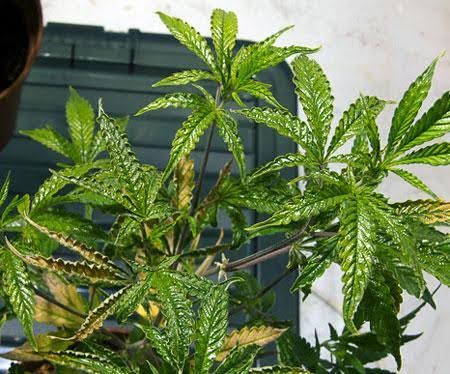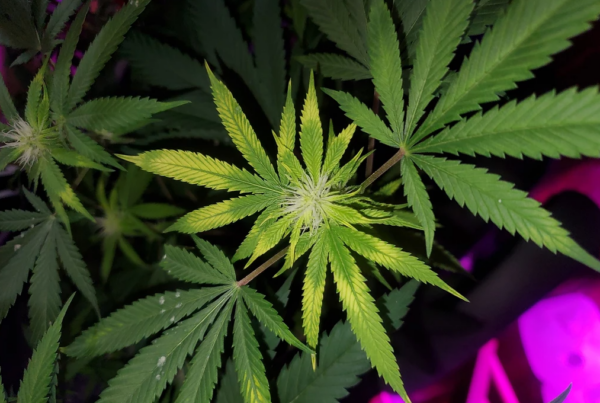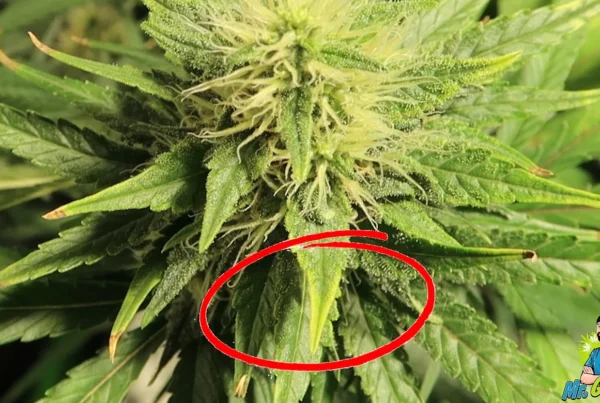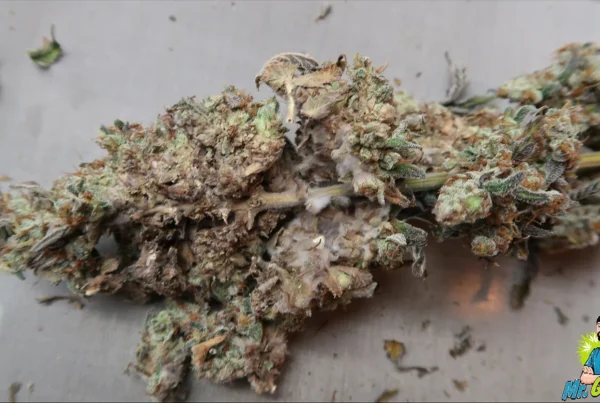Pests and nutrient deficiencies are the biggest challenges when it comes to growing cannabis plants. It gets even more difficult when you cannot see the pests with the naked eye and therefore cannot pinpoint the cause of the various symptoms.
One of these pesky microscopic pests is broad mites, not to be confused with spider mites, that despite the small size, can cause damage to the overall health of the plant and become a hindrance in getting an optimal yield.
This article will not only help you correctly identify the symptoms of broad mites’ infestation but will also provide you with tips and tricks to prevent and treat it.

What are Broad Mites?
Broad mites that go by the scientific name of Polyphagotarsonemus latus belong to the Tarsonemidae family. Broad mites are usually less than 0.2 mm in size which means that they cannot be seen with the naked eye.
Males are smaller than females measuring roughly 0.1mm. They are oval in shape and have four pairs of legs. Their color ranges from translucent and white to pale brown. Broad mites are usually found on the underside of the cannabis plants’ leaves.
They also prefer new growth or leaves over old leaves. These microscopic mites lay their eggs on the underside of the leaves. The eggs are clear and around 0.08 mm in size. Broad mites can grow in numbers rapidly as the female can lay up to 80 eggs during the small lifecycle of 5 to 13 days. The female can also produce male larvae without mating.
Since broad mites suck out the nutrients from the leaves and secrete toxic saliva that damages the cannabis plant and leads to malformations,it is important that quick measures are taken to eradicate them as soon as possible.

The Life Cycle Stages of Broad Mites
- Eggs: The life cycle begins with the female broad mite laying between 30 to 76 eggs over a period of 8 to 13 days. These eggs are typically laid on the underside of young leaves and hatch within 2 to 3 days.
- Larvae: The larvae emerge from the eggs and immediately start feeding on the plant, focusing on young, tender leaf tissue. This feeding stage lasts about 2 to 3 days.
- Nymphs: Following the larval stage, the broad mites enter a quiescent nymphal phase before developing into adults. This transition is rapid, contributing to their fast population growth.
- Adults: Adult broad mites continue the cycle of feeding and reproducing, with the entire life cycle from egg to adult taking about 5 to 13 days, depending on environmental conditions.
Symptoms of Broad Mites Infestation
Since broad mites can only be seen under a microscope, it is easy to mistake an infestation with nutrient deficiencies, over-watering, pH problems, light and heat stress, and tobacco mosaic virus. Here are a few broad mite symptoms that can help you diagnose and control broad mites’ infestation correctly:
- Impact on new leaves: Broad mites prefer feeding and laying their eggs on the underside of new leaves. This is the reason that you may see new growth being impacted first due to a broad mite infestation. This includes new leaves being contorted, twisted, and droopy.
- Blistery Appearance: Another telltale sign of broad mite infestation is the plastic-like and wet appearance of leaves. The leaves look shiny as if there are small blisters on them.
- Curled Edges: Wet appearing or glossy leaves with edges folded or turned upwards is an indicator that broad mites are feeding on your cannabis plant.
- Droopy Leaves: Droopy leaves at the top of the plant is another sign that you should look for.
Broad mites feed on the cannabis plant and affect its overall health and appearance. The plant weakens, leaves start turning yellow and in the flowering stage, buds die leading to a bad harvest. Broad mites can also infest other plants; therefore it is recommended to act swiftly once you notice these symptoms.
Misidentification of Broad Mites on Cannabis Plants
Broad mites are often confused with other garden pests, leading to ineffective treatment strategies.
Here’s an overview of pests commonly mistaken for broad mites and how to distinguish them:
Spider Mites: Unlike broad mites, a spider mite is visible to the naked eye and spin fine webs on plants. They cause white or yellow spots on leaves, leading to a stippled appearance. Spider mites thrive in dry conditions, a key differentiator from broad mites.
Cyclamen Mites: Similar in size to broad mites, cyclamen mites are greenish and transparent. Their damage includes upward curling of leaves that become stiff and brittle. Broad mites, in contrast, cause more generalized deformities and leaf bronzing.

Rust Mites and Eriophyid Mites: Rust mites cause rust-like discoloration on leaves, while eriophyid mites are known for galls and leaf curling. These mites’ small size and impact on plant growth can resemble broad mite damage.
Tarsonemid Mites: Tarsonemid mites attack young plant parts and prefer high humidity. They cause stunted growth and deformation in flowers and leaves, similar to broad mites.
Russet Mites: These mites are elongated and pale, different from the broad mites in shape and color. Their damage typically starts as yellowing or bronzing at the lower leaves, progressing upwards, without the pronounced curling seen with broad mites. Russet mites infest the entire plant, moving upward as they increase in number.
For accurate identification, using magnification tools like microscopes or strong magnifying glasses works great as mites are a lot smaller than fungus gnats, for example. Observing specific damage patterns and understanding the preferred environmental conditions for each of the different types of mite helps too.
Treatment for Broad Mites
Treating broad mite infestations can be tricky like any other mite. Many commercially available miticides that are effective against mites like spider mites can be futile against broad mites. Many growers have found success by rotating different treatments to get rid of the mite populations.
Here are a few steps you should take before using any treatments:
- Removing or pruning the affected parts of the cannabis plants can help prevent them to invade other parts of the plant. Since the affected growth cannot recover, it is better to get rid of it to save the rest of the plant.
- Stay consistent in your efforts when you start the treatment. Broad mites can come back if you stop the treatment thinking that your cannabis plant is showing signs of recovery.
- If you resort to using strong treatments in case of bad infestation, it is better to apply them when its dark to prevent any light burn.

Here are a few treatments that you can use in rotation to eradicate broad mites:
- Neem Oil: Neem oil is a go-to solution for many cannabis growers when it comes to pests. All you need is a sprayer or a mister and a bottle of neem oil. Since it can leave a smell on the buds, it is not recommended to use it during the flowering stage.
- Essentria IC3: Essentria IC3 is an organic treatment that is known to be effective against many pests including broad mites. This mixture of horticultural oil can be sprayed directly on the plant but does require re-application as it is only effective for 8 hours.
- Insecticidal Soap: Insecticidal salts or fatty acid salts kill pests on contact and do not affect other beneficial bugs. But they should be used alongside other treatments as they alone cannot kill broad mites.
- Miticides: There are a few miticides that you can use to treat a serious broad mite infestation. Broad mites are known to develop resilience against miticides, therefore, do not continue using one solution consistently. Avid miticide is a strong insecticide that can be sprayed on the plant with a mister. Switch to another miticide once have used Avid two times in a row. Another effective miticide is Forbid which works by infiltrating the plant cells. It is not recommended to use it during flowering stages as these miticides can stay in the system for a few weeks. Since these are harsh chemicals, you must follow the instructions on the bottle.
- Predatory Mites: Although predatory mites will not get rid of broad mites entirely, they can act as a controlling mechanism. Mites like Noeseiulus feed on broad mites and can help in reducing their numbers.
Using these treatments in combination consistently will help you treat a broad mite infestation. Continue using the treatment for a few days even if your plant starts showing signs of recovery. Prevention is better than cure so ensure that your grow room has proper ventilation and temperature to keep these mites at bay in the future. Monitor your plants daily to tackle this issue early on in case it occurs!
![]()












